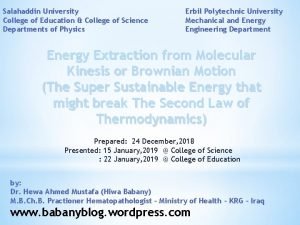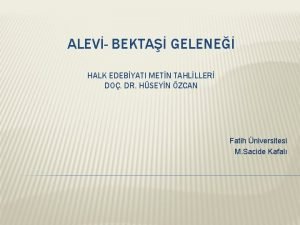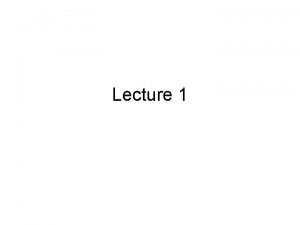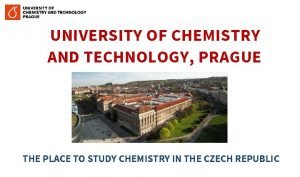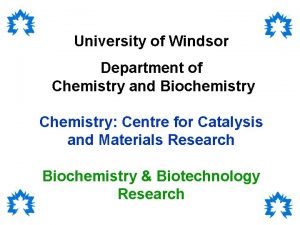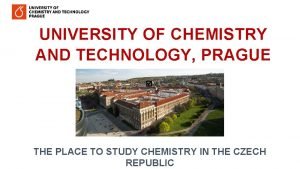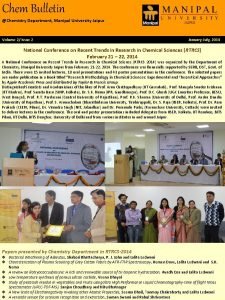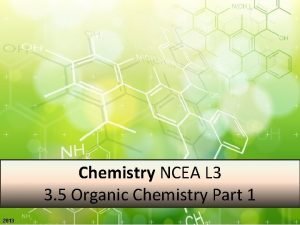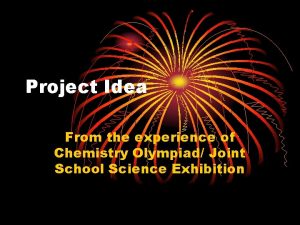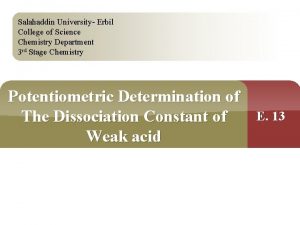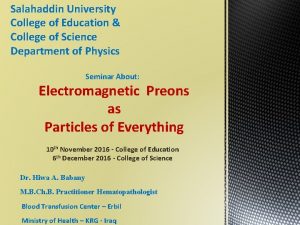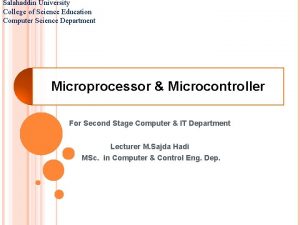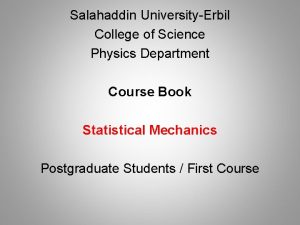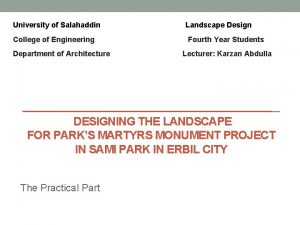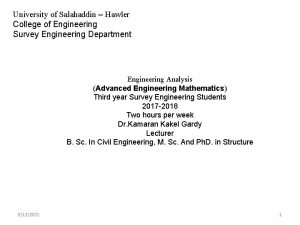University of salahaddin College of science Chemistry depertment














- Slides: 14

University of salahaddin College of science Chemistry depertment Determination of silicon by atomic absorption spectroscopy A review Prepared by : Malik Hersh Hassan Supervisor : Ms Pary Mahdi Arif

Silicon • Silicon is a chemical element with symbol Si atomic number 14. It is a hard and brittle crystalline solid with a blue-grey metallic lustre ; and it is a tetravalent metalloid and semiconductor. It is relatively unreactive. Silicon Silica Quartz

Occurnce of Silicon • Silicon is the eighth most common element in the universe by mass, but very rarely occurs as the pure element Earth's crust. It is most widely distributed in dusts sands, planetoids, and planets as various forms of silicon dioxide (silica) or silicates. More than 90% of the Earth's crust in composed of silicate minerals, making silicon the second most abundant element in the Earth's crust (about 28% by mass) after oxygen. Some plant species contain up to 16% silica in the dry residue. The highest silicon content is found in rice (Oryza sativa) and horsetails.

Uses of silicon in Industrial • 1 - crystalline silicon solar cells are interconnected into solar modules (panels), which can be used For a photovoltaic system for electricity generation and supply. • 2 -Silicates are used in port land cement for mortar and stucco, and mixed with silica sand gravel to make concrete for walkways, foundations, and roads. • 3 - They are also used in white ware ceramics such as porcelain, and in traditional quartz-based soda-lime glass and many other specialty glasses. • 4 - Silicon is the basis of the widely used synthetic polymers called silicones.

• 5 - Most silicon is used commercially without being separated, and often with little processing of the natural minerals. Such use includes industrial construction with clays, silica sand, and stone. • 6 - Silicones often are used in waterproofing treatments, silicon also significantly improves the hardness.

Use Silicon in Medicine • 1 - There is some evidence that silicon is important to human health for their nail, hair , bone , and skin tissues and silicon is needed for synthesis of elastin and collagen. • 2 - Silicon is predominantly and rapidly excreted in the urine, with smaller amounts being eliminated in the feces. Silicon deficiency has not been officially established as such in humans.

• 3 - Silicon is necessary for the growth and bone calcification and as a biological crosslinking agent of connective-tissue-based membrane structures. • 4 - It has also been suggested that silicon and silicic acid may decrease the bioavailability of aluminum by blocking the uptake of the latter by the gastrointestinal tract and impeding its reabsorption in the kidneys, thus protecting an organism against the toxic (especially neurotoxic) action of aluminum.

• 5 - it is suggested that silicon is important for optimal collagen synthesis and activation of hydroxylation enzymes, improving skin strength and elasticity.

Atomic Absotion method • In atomic spectroscopy a substance is decomposed into atoms in a flame, furnace, or plasma. (A plasma is a gas that is hot enough to contain ions and free electrons. ) Each element is measured by absorption or emission of ultraviolet or visible radiation by the gaseous atoms.

Schematic Diagram of an Atomic Absorption Spectroscopy

Hollow – cathode lamp • A hollow-cathode lamp consists of two electrodes that are AAS The material from which the anode is popular sources of radiation for constructed is not particularly critical. Usually the anode is made of tungsten, although nickel and zirconium have also been used the cathode consists of a hollow cylinder that is constructed from the element, an alloy of the element, or a substance that is coated with the element whose spectrum is desired.


References 1. F. B. Braga, S. P. Moreira, P. R. Zamperi, J. M. G. Bacchin, P. R. Mei, 2008, New processes for the production of solargrade polycrystalline silicon: A review, Solar energy materials and solar cells, volume 92, pp. 418 -424. 2. Davy and Humphry. , 1808 "Electro chemical researches, on the decomposition of the earths; with observations on the metals obtained from the alkaline earths, and on the amalgam procured from ammonia, " Philosophical Transactions of the Royal Society [of London], Vol 98 : PP 333– 370. 3. BAREL A. , CALOMME M. , TIMCHENKO A. , DE PAEPE K. , DEMEESTER N. , ROGIERS V. , CLARYS P. , VANDEN BERGHE D. 2005. Effect of oral intake of choline-stabilized orthosilicic acid on skin, nails and hair in women with photodamaged skin. Arch. Dermatol. Res. , 297(4): 147 --153.

4. Carlisle, EM. 1972, Silicon: an essential element for chick , science. P 178. 5. Schwartz K. 1972. Growth promoting effects of silicon in rats. Nature, vol 4 , pp 239 -333. 6. Kazimierz P. and Anna B. , 2011, silicon in medicine and therapy, J. Elem. pp 489 -497. 7. Robert D. broun. 1987. introduction to instrumental analysis. pp 182 -198.
 Salahaddin university college of education
Salahaddin university college of education Ahsen rayman ergün
Ahsen rayman ergün 沈榮麟
沈榮麟 Subject science
Subject science Ib chemistry organic chemistry
Ib chemistry organic chemistry Organic vs inorganic chemistry
Organic vs inorganic chemistry Brooklyn college organic chemistry
Brooklyn college organic chemistry Excelsior college writing
Excelsior college writing University of chemistry and technology, prague
University of chemistry and technology, prague University of windsor chemistry
University of windsor chemistry University of chemistry and technology prague tuition fee
University of chemistry and technology prague tuition fee Manipal university chemistry department
Manipal university chemistry department Chapter 1 chapter assessment the central science
Chapter 1 chapter assessment the central science Gz science chemistry
Gz science chemistry Environmental chemistry science olympiad
Environmental chemistry science olympiad
